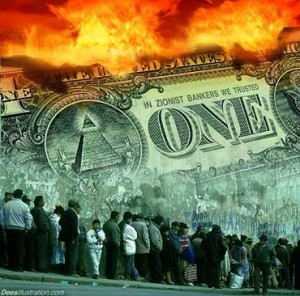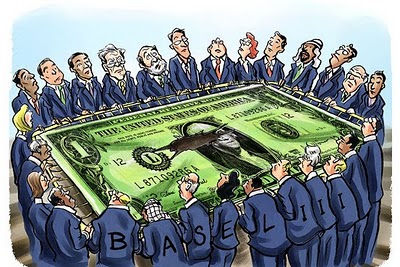
The Basel Committee and the Global Banking Mafia
Valentin Katasonov
4th Media| Friday, May 10, 2013
The Basel Committee on Banking Supervision (hereinafter – the Committee) is closely associated with supranational organisations like the Bank for International Settlements in Basel (BIS), which is often called the «club», the «headquarters» of central banks or the «Central Bank of Last Resort». The Committee’s office is situated in the BIS building.
At the end of 1974, following the disequilibrium of international currencies and banking markets caused by the collapse of the Herstatt Bank in West Germany, the heads of central banks in the G10 countries established the Committee under the auspices of the BIS to develop common international rules with regard to banking supervision.
The Committee formulates common standards for banking supervision and recommendations for their implementation, on the assumption that national authorised bodies (first and foremost central banks) will push them forwards in their own countries. With regard to G10, this is the group of countries that signed a general agreement on borrowing with the IMF in 1962 (Belgium, Great Britain, West Germany, Italy, Canada, the Netherlands, France, Sweden, the USA and Japan).
Switzerland, which was not a member of the IMF, joined in 1964, but the name of the group remained as before. Representatives from Luxembourg were also included in the Basel Committee from the very beginning and, from 2001, the Committee has included representatives from Spain.
At present, the Committee includes representatives from central banks and national authorities on banking supervision from 27 countries (the 13 countries already mentioned along with Argentina, Australia, Brazil, China, Hong Kong, India, Indonesia, Korea, Mexico, Russia, Saudi Arabia, Singapore, South Africa and Turkey, which all joined the Committee in 2009).
Over almost four decades of its activities, the Committee has published tens of documents on different areas of activity, including general issues on the organisation of supervision, capital adequacy, all kinds of risk, the corporate governance of lending and borrowing organisations and so on.

The Committee’s key area of activity is the definition of standards on capital adequacy for banks. All of the Committee’s documentation is centred around an incredibly simple ratio: equity : a bank’s capital = capital adequacy ratio.
Kabbalists of the money world are looking for this ratio’s magic number, which would guarantee the stability of the banking system. In fact, the Committee is seeking to legitimise what is a crime. In Europe, a system of so-called partial, or incomplete, coverage of obligations by banks as borrowing and lending organisations has already existed for a long time (at least since the 18th century). Figuratively speaking, this system allows banks to make money «out of thin air».
For example, for every 1 dollar of lawful money that depositors place in a deposit account, banks are allowed to release 5 or 10 dollars of non-cash (credit) money by way of credit. This used to be called counterfeiting and was strictly punishable by law.
Nowadays, it is called the «norm» or «principle» of banking, legalised by national laws, and in economic textbooks it is known as the «money multiplier». The principle of «partial» coverage (reservation) is «protected» by a supranational structure called the «Basel Committee on Banking Supervision», which lends the principle an appearance of respectability.
No cunning standards and formulae will remove the main effect of the «partial» coverage (reservation) of obligations – the banking crises. In the almost four decades that the Committee has existed, the world has been witness to a countless number of banking failures and crises.
In order to prevent such problems, obligations need to be covered 100 percent, but then banks would be deprived of the opportunity to engage in their own «financial alchemy».
There is a strict taboo on the honest and frank discussion of «partial» reservation both in central banks and the Committee: they are trying to convince the public that it is possible to invent a «magical formula» for capital adequacy so that banks can continue to make money «out of thin air» as before.
This is outright deception.
Basel I and Basel II – straws for the drowning
Up to the end of 2012, two fundamental documents had been implemented by the Committee that defined the «magical formula» for capital adequacy and recommended that this formula be used by national authorities on banking supervision – Basel I and Basel II.
The first of these came into existence in 1988 and had the very respectable name of the «International Convergence of Capital Measurement and Capital Standards» (Basel I).
This agreement defined the minimum capital adequacy ratio as 8 percent, calculated as the ratio of equity (regulated by the supervisory authority) to risk weighted assets.
Only credit risks are taken into account (although a bank’s capital can be made up of investments as well as credits). In fact, the Committee gave the go-ahead for a financial-monetary orgy, respectfully called «the development of monetary and financial markets» in economic textbooks.
The markets began to «blister», the «blisters» began to burst and the real economy and ordinary people suffered the most. To date, more than 100 countries in the world adhere to the rules of Basel I, according to the official declaration.
At the turn of the century, a new version of the standard began to be prepared called Basel II, which was to start in 2004. The new version contained extremely feeble attempts to take account of new banking risks (besides credit risks), especially in view of the rapid development of derivatives markets, the emergence of hedge funds and other institutional speculators, with which banks were extremely closely linked.
At the height of implementing the new standard, the financial crisis of 2007-2009 broke out. It once again demonstrated that the Basel standards are no more than a fig leaf covering the tyranny of the world’s usurers.
Basel II was unable to cure the world’s moneylenders of their greed, the global banking giant Lehman Brothers sank to the depths in front of everybody’s eyes and, in order to save others, America was forced to spend upwards of three trillion dollars from the public purse, with Europe spending about the same.
There were even attempts to prove that it was the implementation of Basel II that had caused the start of the financial crisis, since in order to make up for the lack of equity, banks decided to use extremely risky methods to attract capital and had to go as far as falsification and outright deception (accounting offences, the use of off-balance sheet transactions, etc.).
During the financial crisis, the Committee began to spasmodically introduce changes and amendments to the Basel II standard.

The features of Basel III
At long last, a new document emerged called Basel III. Proposals for Basel III were approved at the G20 Summit in Seoul in November 2010. Participants at the Summit also approved the timeline for the phased implementation of the standard. 1 January 2013 was given as the start date. The new document is exceedingly complex and voluminous, numbering nearly 800 pages.
I would like to draw your attention to the following features:
1. The timeline for implementing the standard stretches to 2018; in other words, the standard is not «strict», it gives banks enough time for manuever;
2. The bar for the capital adequacy ratio of banks was raised, but not so much that it would avoid new crises;
3. The role of the «human factor» in the assessment of banks by supervisory authorities was increased; and
4. Within equity, a special role has been given to gold as a financial asset.
In my opinion, the last feature is the most important; it is a high-quality innovation that distinguishes Basel III from Basel II.
In previous Basel standards, only cash (which comes under the heading of «legal tender» in all countries) and government debt securities – Ministry of Finance and Treasury bonds – were regarded as high-quality equity. Moreover, this did not include all bonds, only those given the highest rating by leading international rating agencies.
For a long time, the highest quality form of equity was considered to be US Treasury bonds. In other words, the banks in those countries that took part in Basel I and Basel II must have been helping Uncle Sam by purchasing US bonds and covering up the holes in the US budget, thereby supporting the US dollar and working against gold as the main rival to «green paper».
«Basel III»: the partial rehabilitation of gold
Before the 1970s, when the Bretton-Woods currency system existed in the world and there were not yet any «Basel» standards, everything was different. Banks were principally valued in terms of the amount of gold in their equity. The more gold there was relative to the total amount of capital and the total amount of assets, the safer the bank was believed to be. It was all simple, clear and logical.
However, those good old times came to an end with the collapse of the gold standard and the IMF’s decision to carry out a full and final demonetisation of gold. Gold was demoted to a run-of-the-mill exchange commodity like oil, wheat or coffee. As a last resort, banks could use gold as an investment medium, but the metal stopped being regarded as a valuable financial asset.
Up to now, the Bank for International Settlements (BIS) has stored the gold in its «black body», so to speak. On the whole, the rules of the game were such that there was no benefit in banks hoarding their gold. At best, bankers regarded the yellow metal with the eyes of speculators buying and selling gold to make short-term profits.
Basel III has raised the status of gold dramatically. New rules have been provided to transfer gold to a bank’s tier 1 capital at 100 percent of its value. Banks now have the opportunity to replace their paper assets (primarily US Treasury bonds) with gold.
Experts have calculated that such a practice will create additional demand for the precious metal to the extent of at least 1700 tonnes. There have been even higher estimations of up to 3000 tonnes. A number of experts believe that the development of Basel III was carried out with powerful lobbying from the Rothschilds, who have an interest in restoring the monetary status of gold in the world.
For the last two centuries, the Rothschilds have had control over the main gold reserves, been involved in the extraction of gold and are «market makers» in the precious metals market.
In September 2012, before the Basel Committee’s new standard had even come into force, the heads of one of the world’s largest banks, Deutsche Bank AG, which falls within the Rothschilds’ sphere of influence, made a public statement that gold had again been transformed from a commodity into money.
The statement caused a painful reaction on the other side of the Atlantic Ocean, first and foremost in the US Federal Reserve System. The chairman of the Federal Reserve, Ben Bernanke, once again issued a standard statement that gold was far from the best type of money.
It is not difficult to see that Basel III is a blow to the US dollar and the American economy. America’s reaction was sufficiently prompt and harsh.
At the end of last year, America’s monetary and financial regulators (the Federal Reserve system, the Deposit Insurance Agency and the Office of the Comptroller of Currency) reported that they had been sent a petition by leading American banks stating that the new Basel standards were crippling for lending and borrowing organisations.
After this, the Federal Reserve System and other US financial regulators went to the Committee and announced that the introduction of Basel III in America was being postponed, and no date for transition to the new standard was given.
At this point, European banks started to feel anxious, believing that if they began the transition to the new standard, they would find themselves incompetitive in comparison with American banks.
Therefore, they also refused to shift to Basel -III. So who exactly has embraced Basel III since 1 January 2013?
The list is not very long, with a total of 11 countries in all: Australia, Hong Kong, Canada, China, Mexico, Saudi Arabia, Singapore, Thailand, Switzerland, South Africa and Japan. It is also possible to add India here, which announced it would be joining Basel III from 1 April 2013.
It is remarkable that the list contains just four countries from the «golden billion» zone: Australia, Canada, Switzerland and Japan.
Turkey’s absence from the list is mysterious. The country actively encourages the wide use of gold in banking operations, and the proportion of gold in the equity and assets of Turkey’s banks compared with other countries is high. In reality, the Turkish banking sector is completely ready to implement the Basel III standards.
As the London newspaper the Financial Times observed, the policy of the governor of the Central Bank of Turkey, Erdem Başçı, has yielded impressive results for Turkish banks: they have attracted 8.3 billion US dollars in new deposits through gold programmes over the last 12 months and are now able to channel these resources into lending.
One can observe that nearly all the leading gold producers are on the list given above: China, South Africa, Canada and Australia. A number of the countries on the list are leading importers of gold (China, Hong Kong, Switzerland, Saudi Arabia and India).
China, which has been included on the list of «golden» leaders, has long been hinting at the possibility of transforming the Yuan into a gold standard. Switzerland, meanwhile, is pushing forward a project to introduce a parallel currency within the country in the form of a gold franc.
«Basel III»: banks’ U-turn on gold
The implementation of the new Basel rules could lead to a radical change in the positions of individual countries’ banks in the global financial system.
To begin with, it is expected that the positions of Chinese banks will become stronger, bearing in mind that for several years in succession, China has ranked first in the world in terms of the volume of gold both extracted and imported. The positions of those banks that bravely embraced Basel III will also become stronger, since the price of gold over the last 12 years has shown an unprecedentedly high growth rate – an average of 17 percent per year. In 2012, a troy ounce of gold cost 1700 dollars.
According to many gold traders, meanwhile, the «fair» («equilibrium») value of metal is at a level of no less than 5000 dollars. Whoever managed to get on the «gold train» by buying low-cost tickets will be much more likely to find themselves on the global financial Olympus tomorrow.
Even those banks that have still not entered the zone of Basel III activities understand that their future depends on how quickly they will be able to turn towards gold. IMF and World Gold Council statistics do not give a clear picture of gold purchases by the entire banking sector. However, there are statistics for the purchase and sale activities of central banks in the gold market.
Following the collapse of the Bretton-Woods currency system, central banks across the world sold more gold than they bought for more than three decades.
After the recently concluded financial crisis, the situation changed dramatically. In 2011, net purchases of gold by the world’s central banks amounted to 457 tonnes.
This is more than 10 percent of the total demand for precious metals on the world market (4400 tonnes). During the 15 years preceding the crisis, meanwhile, net purchases totalled an average of 400 tonnes per year. Thus, the central banks made a sharp about turn and started to purchase gold in the kinds of volumes that had not been observed since the 1960s.
Last year was a record year in terms of the amount of net purchases of gold by the world’s central banks since 1964. According to preliminary data released by the World Gold Council, a new record will also be set in 2012: the net purchase of gold by the world’s central banks rose to 536 tonnes.
With regard to commercial banks, before the introduction of the Basel III standard they only saw gold as a way to increase their own profits through speculation and/or investment, but they had no incentive to establish their own considerable reserves of precious metals.
I think their attitude to gold is going to change in 2013, they will buy it for themselves with a view to improving the sustainability of their business and attracting clients.
The validation of the Basel III standards in a number of countries in 2013 is a serious indication that gold has returned to the world of money. We are not yet talking about the classical gold standard, of course, whereby banks are able to freely exchange paper money for metal.
But metal may become more widely used to cover banks’ liabilities and be a financial asset of the «highest authority». Who knows, maybe in the future, when banks have accumulated enough gold, the issue of the reinstatement of the gold standard will be put back on the agenda…
Valentin Katasonov / Strategic Culture Foundation



